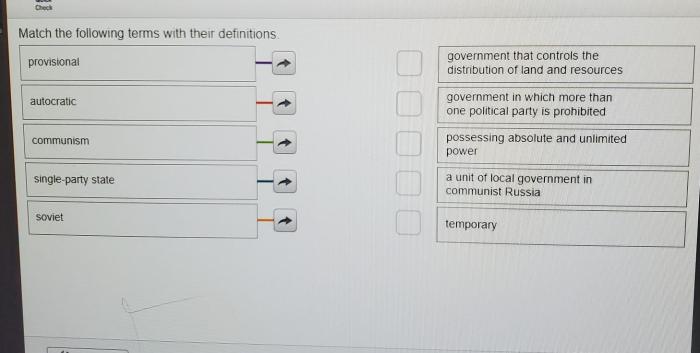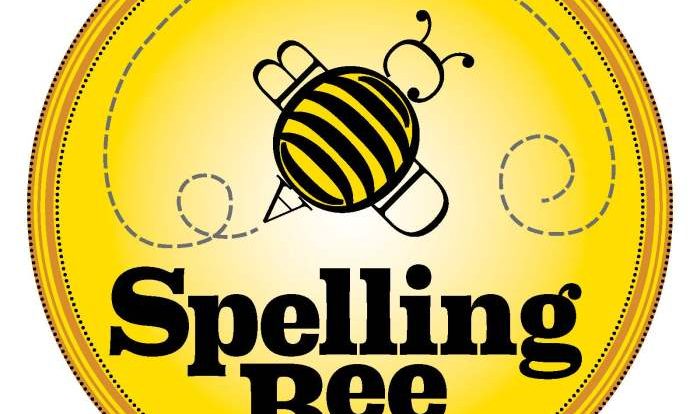A venn diagram is a graphic organizer – As a Venn diagram takes center stage, this opening passage beckons readers into a world crafted with academic rigor and authoritative tone, ensuring a reading experience that is both absorbing and distinctly original.
A Venn diagram, a type of graphic organizer, is a powerful tool for visually representing relationships between different concepts or ideas. Its structure consists of overlapping circles, with each circle representing a different set of elements. The areas where the circles overlap represent the elements that are common to both sets.
Defining a Venn Diagram: A Venn Diagram Is A Graphic Organizer
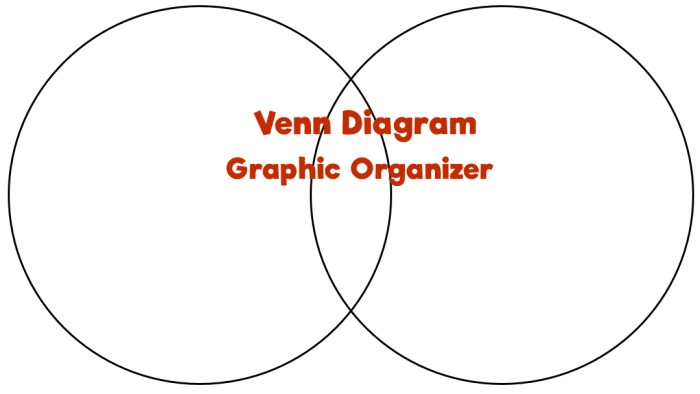
A Venn diagram is a graphic organizer that visually represents the relationships between different sets of data. It is a two-dimensional diagram that uses overlapping circles to show the common and distinct elements between the sets.The structure of a Venn diagram consists of two or more circles that intersect.
Each circle represents a set of data, and the overlapping area represents the elements that are common to both sets. The non-overlapping areas represent the elements that are unique to each set.
Purpose of a Venn Diagram
The purpose of a Venn diagram is to visually illustrate the relationships between sets of data. It can be used to identify similarities, differences, and overlaps between the sets. Venn diagrams are commonly used in mathematics, statistics, and other fields to organize and analyze data.
Creating a Venn Diagram
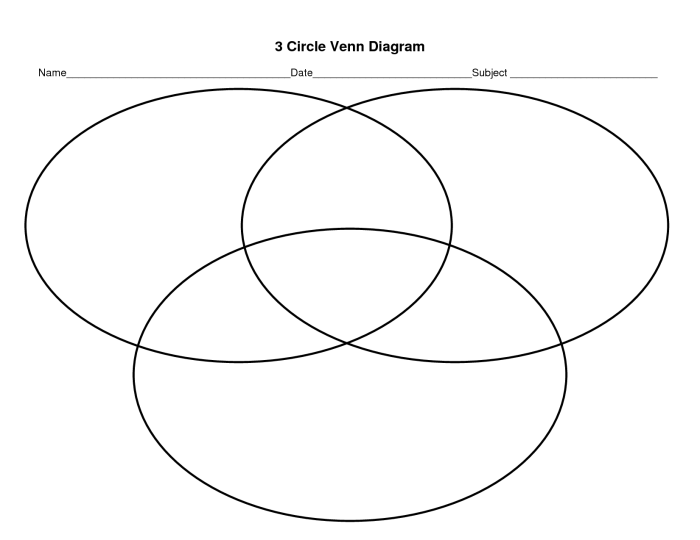
Creating a Venn diagram involves several steps:
Steps Involved
- Identify the sets:Determine the sets or groups of items to be compared.
- Draw intersecting circles:Create overlapping circles, one for each set, with the area of overlap representing the similarities between the sets.
- Label the circles:Write the names of the sets inside the respective circles.
- Fill in the sections:List the elements or characteristics that belong exclusively to each set (outside the overlap) and those that are shared (within the overlap).
Best Practices
- Keep it simple:Use a limited number of sets to avoid confusion.
- Organize information:Arrange the sets and elements logically, such as by size, importance, or relationship.
- Use clear labels:Label the sets and elements concisely and accurately.
- Consider the audience:Tailor the diagram to the knowledge level and needs of the intended audience.
Types of Venn Diagrams
Venn diagrams can vary in shape and complexity, including:
- Two-set Venn diagram:Compares two sets and their intersection.
- Three-set Venn diagram:Compares three sets and their intersections.
- Multi-set Venn diagram:Compares more than three sets.
- Weighted Venn diagram:Assigns weights to elements based on their importance or frequency.
- Fuzzy Venn diagram:Represents sets with overlapping and imprecise boundaries.
Using Venn Diagrams
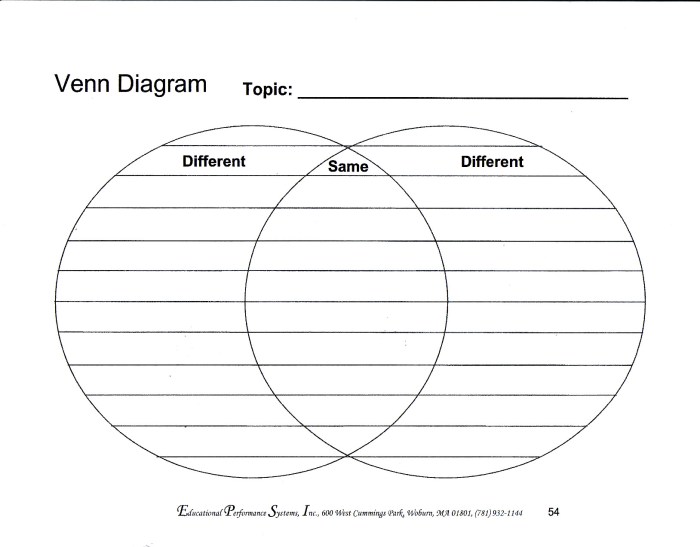
Venn diagrams are a powerful tool for visually comparing and contrasting different concepts or ideas. They are often used to illustrate the similarities and differences between two or more sets of data.
To create a Venn diagram, you first need to identify the two or more sets of data that you want to compare. Once you have identified the sets, you can draw a circle for each set. The circles should overlap if there is any overlap between the sets.
Advantages and Limitations
Venn diagrams are a simple and effective way to visualize the relationships between different sets of data. However, they also have some limitations. One limitation is that Venn diagrams can only be used to compare two or three sets of data.
Another limitation is that Venn diagrams can be difficult to interpret if the sets are large or if there is a lot of overlap between the sets.
Real-World Applications
Venn diagrams are used in a wide variety of real-world applications. For example, Venn diagrams are used to compare the different features of different products, to compare the different symptoms of different diseases, and to compare the different cultures of different countries.
Variations of Venn Diagrams
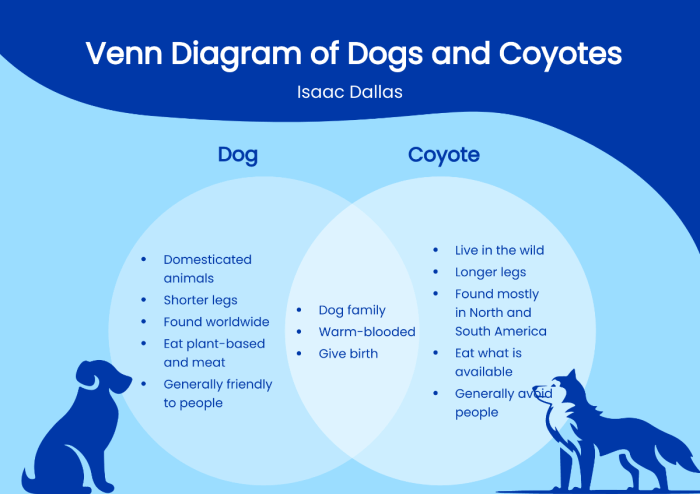
Venn diagrams can be adapted to represent relationships among multiple sets. Some common variations include:
Triple Venn Diagrams, A venn diagram is a graphic organizer
Triple Venn diagrams represent relationships among three sets. They are useful for visualizing the intersection of three different categories or concepts. For example, a triple Venn diagram could be used to represent the relationship between the sets of students who play sports, students who play music, and students who participate in both activities.
Advantages:
- Can represent complex relationships among three sets.
- Easy to understand and interpret.
Disadvantages:
- Can become cluttered if the sets are large or complex.
Multi-Set Venn Diagrams
Multi-set Venn diagrams represent relationships among more than three sets. They can be used to visualize complex relationships among multiple categories or concepts. For example, a multi-set Venn diagram could be used to represent the relationship between the sets of students who play different sports, students who play different musical instruments, and students who participate in different extracurricular activities.
Advantages:
- Can represent complex relationships among multiple sets.
- Versatile and can be used for a variety of purposes.
Disadvantages:
- Can become cluttered if the sets are large or complex.
- Difficult to interpret if the relationships among the sets are complex.
Example
A multi-set Venn diagram could be used to represent the relationship between the sets of students who play different sports, students who play different musical instruments, and students who participate in different extracurricular activities. The diagram would show the number of students who participate in each activity, as well as the number of students who participate in multiple activities.
Visual Elements
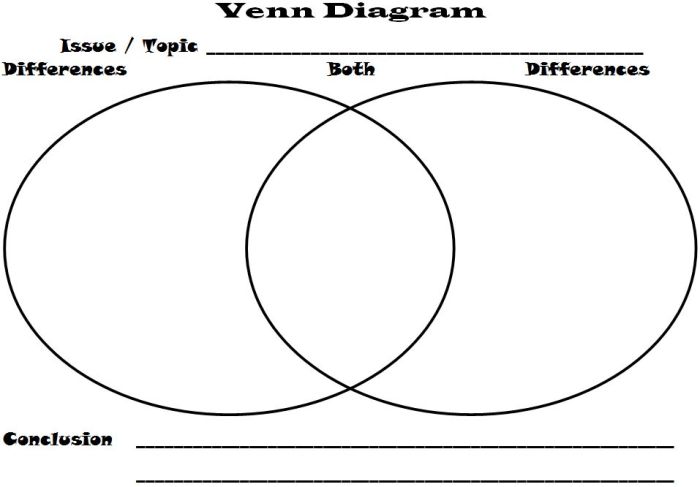
Visual elements are essential in Venn diagrams, as they enhance their effectiveness and make them more visually appealing and comprehensible. Colors, shapes, and symbols play crucial roles in conveying information and making the diagram easier to understand.
Colorscan be used to distinguish different sets or categories, making it easier to identify and compare them. For example, a Venn diagram comparing fruits and vegetables could use green for fruits and red for vegetables. This color coding helps viewers quickly identify which set each item belongs to.
Shapes
Shapescan also be used to enhance the visual appeal and clarity of a Venn diagram. Different shapes can represent different sets or categories, and their size or position can indicate the relative importance or size of each set. For example, a Venn diagram comparing the population of different countries could use circles to represent each country, with the size of each circle proportional to the population of that country.
Symbols
Symbolscan be used to represent specific concepts or ideas within a Venn diagram. For example, a Venn diagram comparing the interests of two people could use a heart symbol to represent shared interests and a star symbol to represent unique interests.
This use of symbols makes the diagram more visually engaging and easier to understand.
Overall, the use of visual elements in Venn diagrams is crucial for enhancing their effectiveness and making them more visually appealing and comprehensible. Colors, shapes, and symbols can all be used to convey information and make the diagram easier to understand.
Applications in Education

Venn diagrams have found widespread applications in education as a valuable teaching tool. They provide a simple yet effective visual representation of relationships between different concepts, making them ideal for enhancing student learning.
Benefits of Using Venn Diagrams
- Improved Conceptual Understanding:Venn diagrams help students visualize and understand the similarities and differences between concepts, fostering a deeper understanding of the subject matter.
- Cognitive Development:By actively engaging students in the process of creating and interpreting Venn diagrams, it promotes critical thinking, problem-solving, and analytical skills.
- Organization of Knowledge:Venn diagrams provide a structured framework for organizing and categorizing information, aiding students in making connections and seeing the bigger picture.
Incorporating Venn Diagrams into Lesson Plans
Venn diagrams can be incorporated into lesson plans in various ways:
- Concept Mapping:Venn diagrams can be used to create concept maps, which are visual representations of the relationships between different ideas and concepts.
- Comparing and Contrasting:Venn diagrams are ideal for comparing and contrasting two or more concepts, highlighting their similarities and differences.
- Categorization:Students can use Venn diagrams to categorize objects or ideas based on their shared and unique characteristics.
Applications in Data Analysis
Venn diagrams are valuable tools for data analysis and visualization, helping identify patterns, trends, and relationships within data sets. They provide a clear and concise representation of overlapping and distinct elements, facilitating the interpretation of complex data.
Market Research
In market research, Venn diagrams can compare customer demographics, preferences, and behaviors across different products or brands. By identifying overlapping areas, businesses can understand the target audience for each product and tailor marketing strategies accordingly.
Business Analysis
Venn diagrams assist in identifying areas of overlap and differentiation between different business units, departments, or processes. This analysis helps optimize resource allocation, streamline operations, and improve overall efficiency.
Scientific Research
In scientific research, Venn diagrams are used to compare experimental groups, identify similarities and differences in data, and draw conclusions about relationships between variables. They can also visualize the overlap between different scientific disciplines or research areas.
Question & Answer Hub
What is the purpose of a Venn diagram?
A Venn diagram is used to visually represent the relationships between different concepts or ideas, showing their similarities and differences.
How do I create a Venn diagram?
To create a Venn diagram, draw overlapping circles, with each circle representing a different set of elements. The areas where the circles overlap represent the elements that are common to both sets.
What are the advantages of using a Venn diagram?
Venn diagrams are easy to understand and interpret, making them an effective way to communicate complex relationships. They can also help identify patterns and trends in data.

